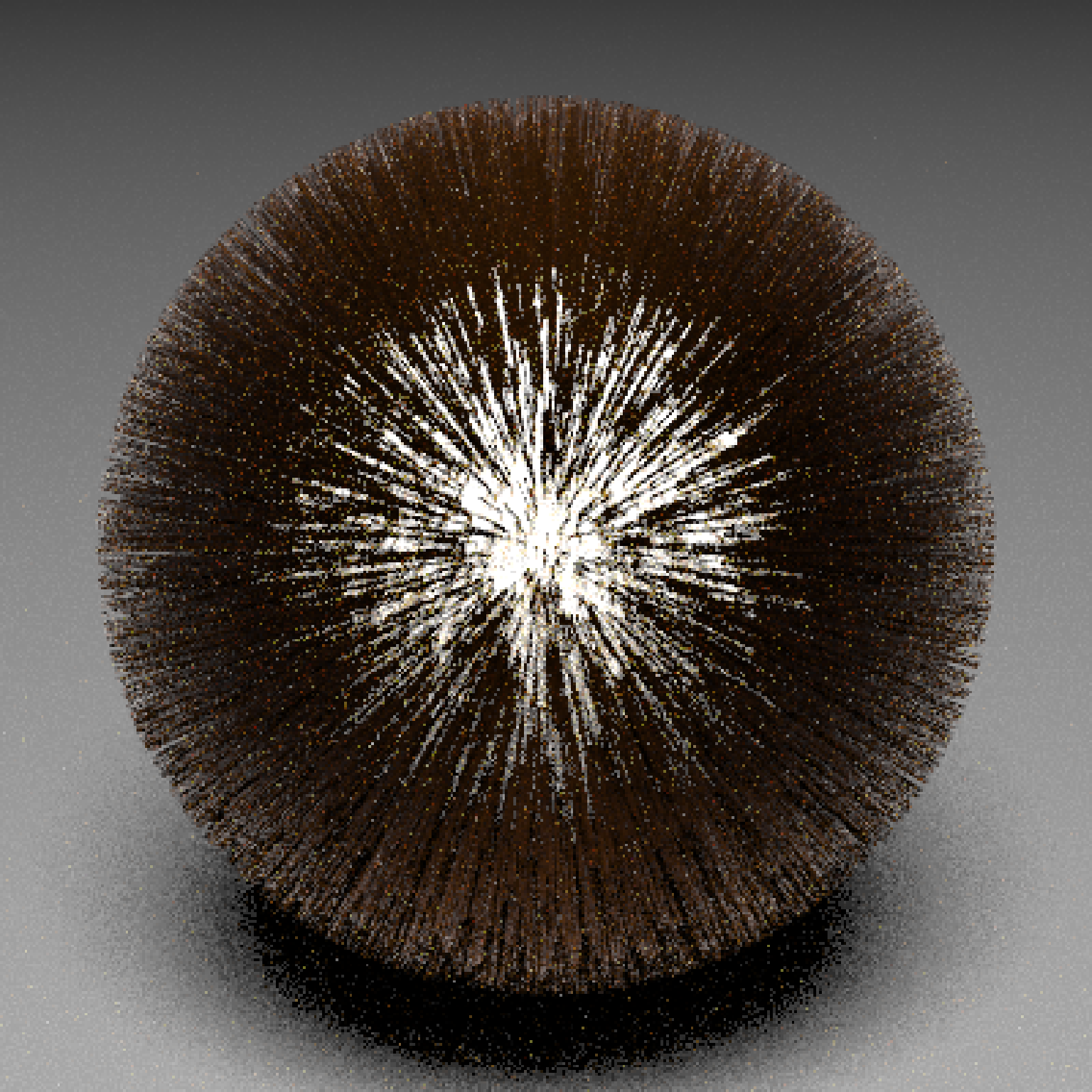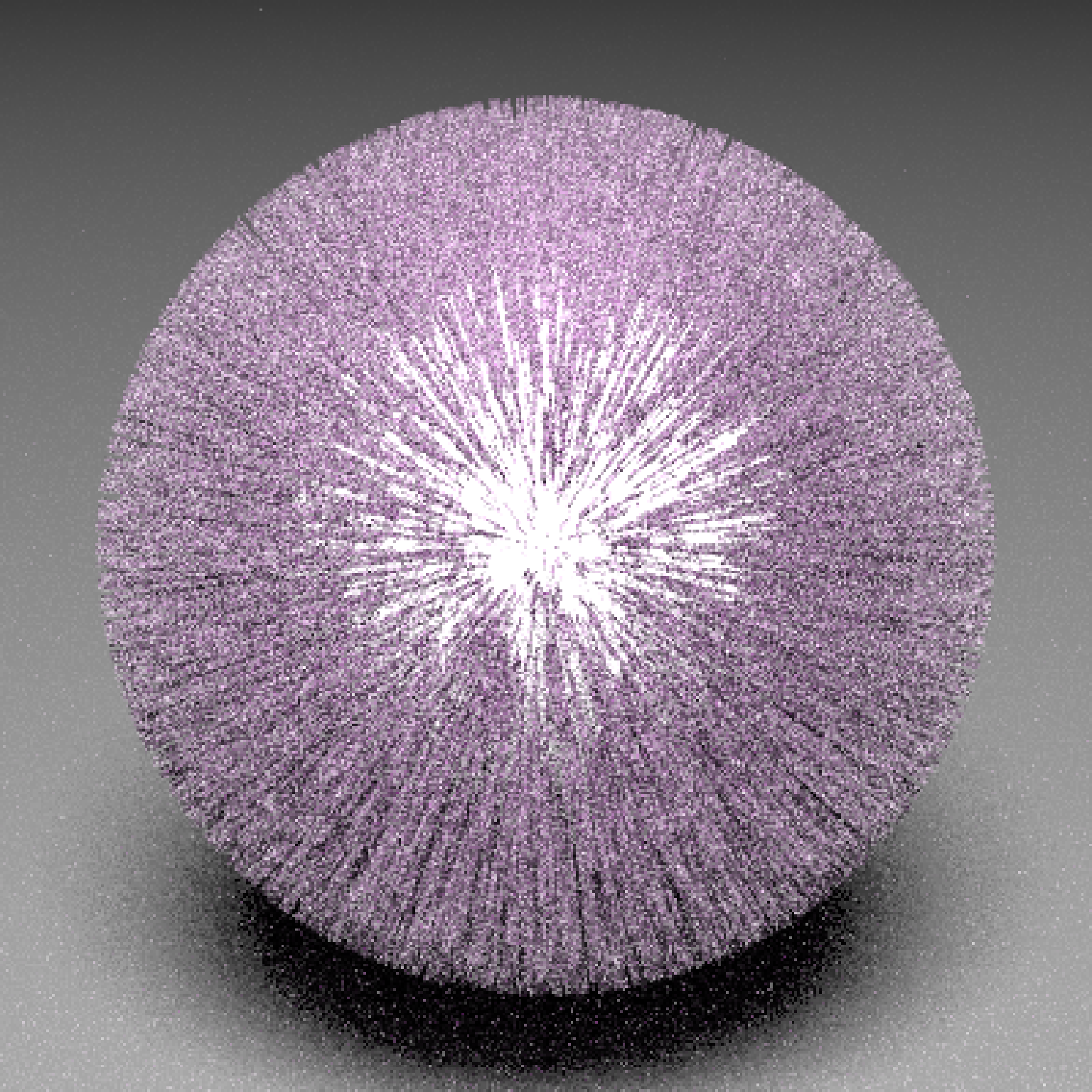Hair Material
hair(
pigment = 1.3,
red_pigment = 0,
color = NA,
sigma_a = NA,
eta = 1.55,
beta_m = 0.3,
beta_n = 0.3,
alpha = 2
)Arguments
- pigment
Default `1.3`. Concentration of the eumelanin pigment in the hair. Blonde hair has concentrations around 0.3, brown around 1.3, and black around 8.
- red_pigment
Default `0`.Concentration of the pheomelanin pigment in the hair. Pheomelanin makes red hair red.
- color
Default `NA`. Approximate color. Overrides `pigment`/`redness` arguments.
- sigma_a
Default `NA`. Attenuation. Overrides `color` and `pigment`/`redness` arguments.
- eta
Default `1.55`. Index of refraction of the hair medium.
- beta_m
Default `0.3`. Longitudinal roughness of the hair. Should be between 0 and 1. This roughness controls the size and shape of the hair highlight.
- beta_n
Default `0.3`. Azimuthal roughness of the hair. Should be between 0 and 1.
- alpha
Default `2`. Angle of scales on the hair surface, in degrees.
Value
Single row of a tibble describing the hair material.
Examples
#Create a hairball
if(run_documentation()) {
#Generate rendom points on a sphere
lengthval = 0.5
theta = acos(2*runif(10000)-1.0);
phi = 2*pi*(runif(10000))
bezier_list = list()
#Grow the hairs
for(i in 1:length(phi)) {
pointval = c(sin(theta[i]) * sin(phi[i]),
cos(theta[i]),
sin(theta[i]) * cos(phi[i]))
bezier_list[[i]] = bezier_curve(width=0.01, width_end=0.008,
p1 = pointval,
p2 = (1+(lengthval*0.33))*pointval,
p3 = (1+(lengthval*0.66))*pointval,
p4 = (1+(lengthval)) * pointval,
material=hair(pigment = 0.3, red_pigment = 1.3,
beta_m = 0.3, beta_n= 0.3),
type="flat")
}
hairball = dplyr::bind_rows(bezier_list)
generate_ground(depth=-2,material=diffuse(color="grey20")) %>%
add_object(sphere()) %>%
add_object(hairball) %>%
add_object(sphere(y=20,z=20,radius=5,material=light(color="white",intensity = 100))) %>%
render_scene(samples=16, lookfrom=c(0,3,10),clamp_value = 10,
fov=20, width=800, height=800)
}
 if(run_documentation()) {
#Specify the color directly and increase hair roughness
for(i in 1:length(phi)) {
pointval = c(sin(theta[i]) * sin(phi[i]),
cos(theta[i]),
sin(theta[i]) * cos(phi[i]))
bezier_list[[i]] = bezier_curve(width=0.01, width_end=0.008,
p1 = pointval,
p2 = (1+(lengthval*0.33))*pointval,
p3 = (1+(lengthval*0.66))*pointval,
p4 = (1+(lengthval)) * pointval,
material=hair(color="purple",
beta_m = 0.5, beta_n= 0.5),
type="flat")
}
hairball = dplyr::bind_rows(bezier_list)
generate_ground(depth=-2,material=diffuse(color="grey20")) %>%
add_object(sphere()) %>%
add_object(hairball) %>%
add_object(sphere(y=20,z=20,radius=5,material=light(color="white",intensity = 100))) %>%
render_scene(samples=16, lookfrom=c(0,3,10),clamp_value = 10,
fov=20, width=800, height=800)
}
if(run_documentation()) {
#Specify the color directly and increase hair roughness
for(i in 1:length(phi)) {
pointval = c(sin(theta[i]) * sin(phi[i]),
cos(theta[i]),
sin(theta[i]) * cos(phi[i]))
bezier_list[[i]] = bezier_curve(width=0.01, width_end=0.008,
p1 = pointval,
p2 = (1+(lengthval*0.33))*pointval,
p3 = (1+(lengthval*0.66))*pointval,
p4 = (1+(lengthval)) * pointval,
material=hair(color="purple",
beta_m = 0.5, beta_n= 0.5),
type="flat")
}
hairball = dplyr::bind_rows(bezier_list)
generate_ground(depth=-2,material=diffuse(color="grey20")) %>%
add_object(sphere()) %>%
add_object(hairball) %>%
add_object(sphere(y=20,z=20,radius=5,material=light(color="white",intensity = 100))) %>%
render_scene(samples=16, lookfrom=c(0,3,10),clamp_value = 10,
fov=20, width=800, height=800)
}
